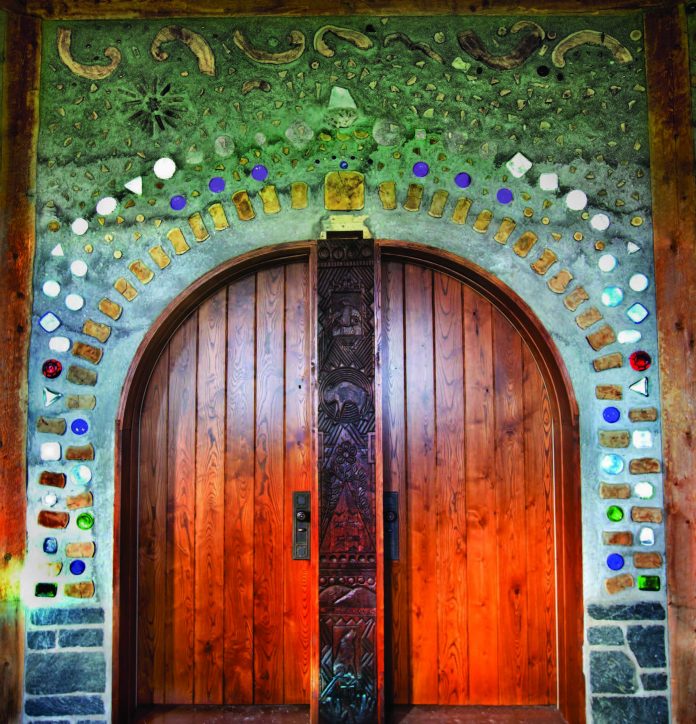Imagine a building style that encourages creativity and whimsy yet manages to be energy efficient and code compliant. If this combination appeals to you, then you should get acquainted with cordwood construction. Cordwood uses natural materials, many of which come from the forest and/or have been recycled or repurposed. It’s cost-effective and utilizes many of the less-than-perfect materials (like hollow centers of cedars, crooked limbs, and downed trees) that might otherwise end up on a trash heap. And the results are stunning.
Cordwood enthusiasts have built cottages, cabins, playhouses, art studios, saunas, yoga-meditation centers, doghouses—you name it, you can build it. Using cordwood, people have erected wonderful “Singing Cordwood Cabanas” in Venezuela and stunning new country cabins in Europe. Cordwood saunas in Minnesota and cabins in Idaho are dotting the landscape.
Cordwood is basically a wall system that uses short log ends, stacked and mortared like a row of firewood, with insulation in the center cavity to provide warmth in winter and coolness in summer. Colored glass bottles placed within the mortar matrix give the look and feel of stained glass. Embedded seashells, gems, and stones can further personalize the structure to the owner’s desires. Using rot-resistant softwoods, a choice of mortars (cob, traditional, papercrete/adobe, lime putty), and a natural insulation material (sawdust), these buildings make for DIY projects that are both imaginative and fulfilling.
Though cordwood construction has been around for more than a century, it’s enjoyed a renaissance in the last few decades and has become an intriguing and distinctive natural building style of the twenty-first century. For many people, cordwood may be the answer to a long-anticipated summer cottage, winter hideaway, or cozy home. It just takes a bit of research and planning.
As you look at the outstanding examples of cordwood and cobwood (cordwood plus cob mortar) on the following pages and hear some builder’s stories (including our own), I hope you’ll be inspired to learn more—and maybe even try it yourself.
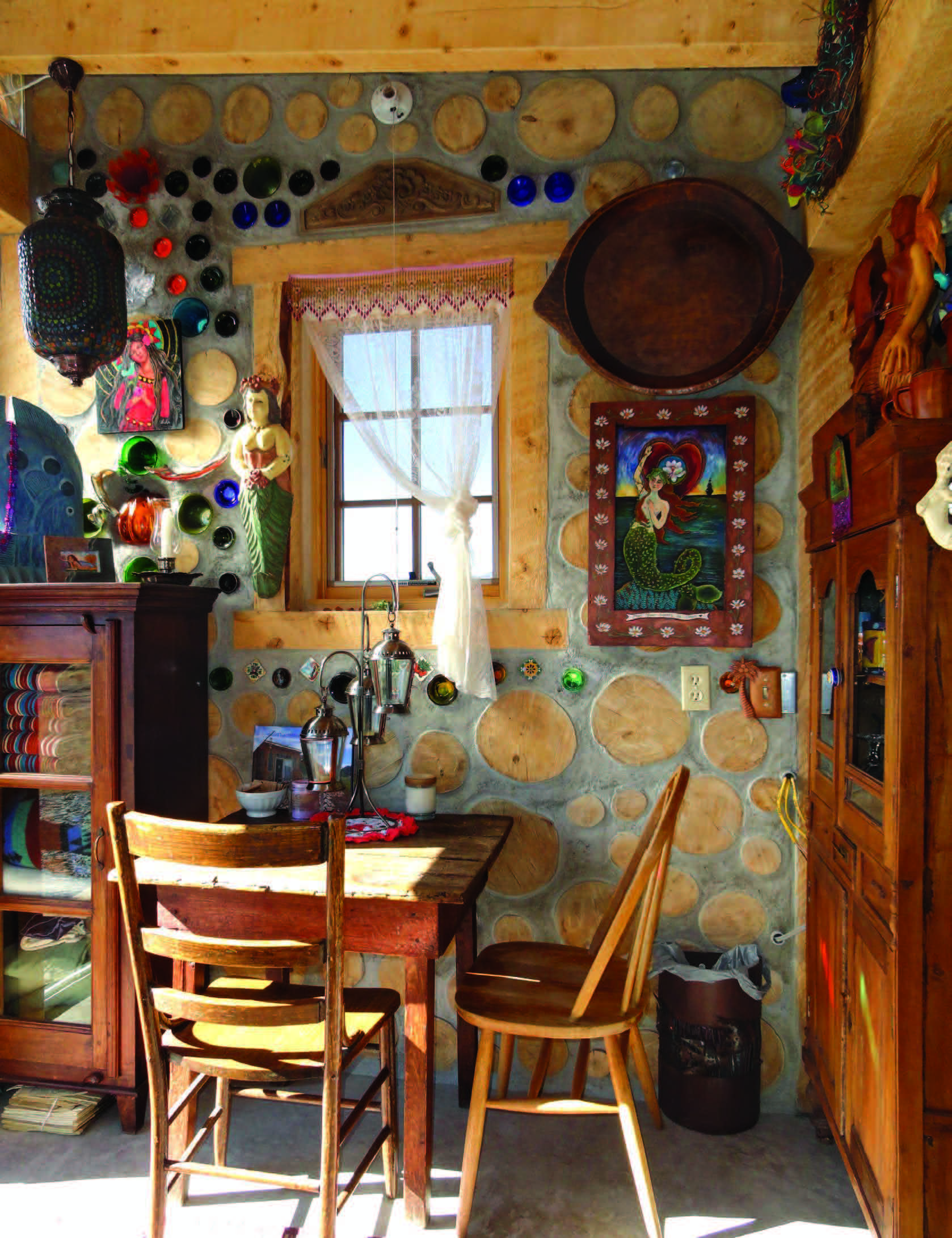
Cordwood along the Mississippi River
Kristine Beck
In Fountain City, Wisconsin, on a gorgeous site overlooking the mighty Mississippi River, Kristine Beck has created a teaching/sharing center and a repository for her family’s lore. After purchasing a portion of the family farm, she set to work creating a cord-wood chapel, a stone circle, a labyrinth, and a dolmen using motifs inspired by mother nature. She lovingly calls the thirty-acre site Kinstone (pictured at left).
“I created Kinstone after a career in software that numbed my spirit, my sense of magic. The need for reconnecting to the Earth and all of its glory drove me to make a major change in my life. I’m a self-proclaimed “megalithic maniac,” a lover of stones. Kinstone is full of standing stones, three stone circles, a dolmen, a labyrinth, and a fabulous thatched cordwood chapel. Designed and built with the help of Wayne Weiseman (a master permaculture designer whom I describe as an earth-lover and Sufi mystic), Ivan McBeth (a Druid who hails from Glastonbury, England), and our multi-talented stone mason, builder, and site manager, Jarad Barkeim, the place is permeated with seasonal and celestial alignments, buried tokens, symbols, and simple magic.
“The chapel has become the heart of Kinstone. Visitors seeking respite, quietude, and joy can find it in the encircling walls of this sacred structure with its well-knit combination of the elements. Earth, wind, wa-ter, fire, and spirit have been woven into the walls by over two hundred hands. The sun, moon, and stars, and the spirits of the trees, flowers, and creatures of the air and earth are all honored there. Behind the arched doors, under the thatched roof, exists an enchanting balm of wonder, refreshment, and love that gets right into one’s soul.” Kinstone Permaculture Academy offers workshops (cordwood, cob, straw/clay, permaculture, bee keeping, planting, foraging, etc.), demonstrations, and touring events near Fountain City, Wisconsin. For a closer look at their offerings, visit Kinstonecircle.com.
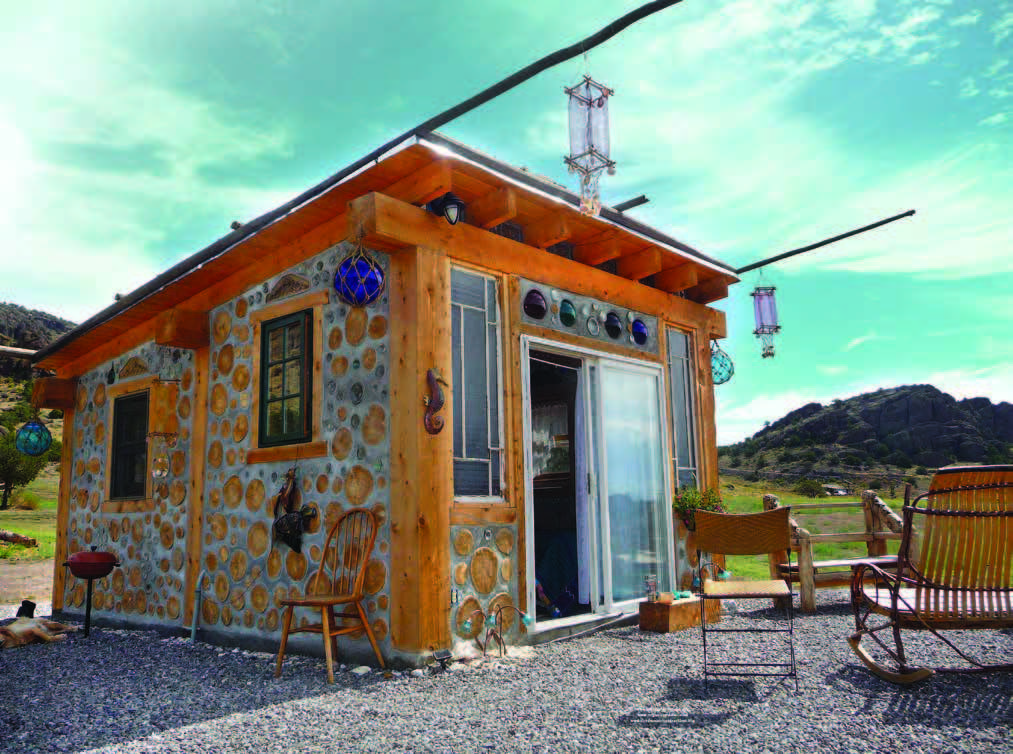
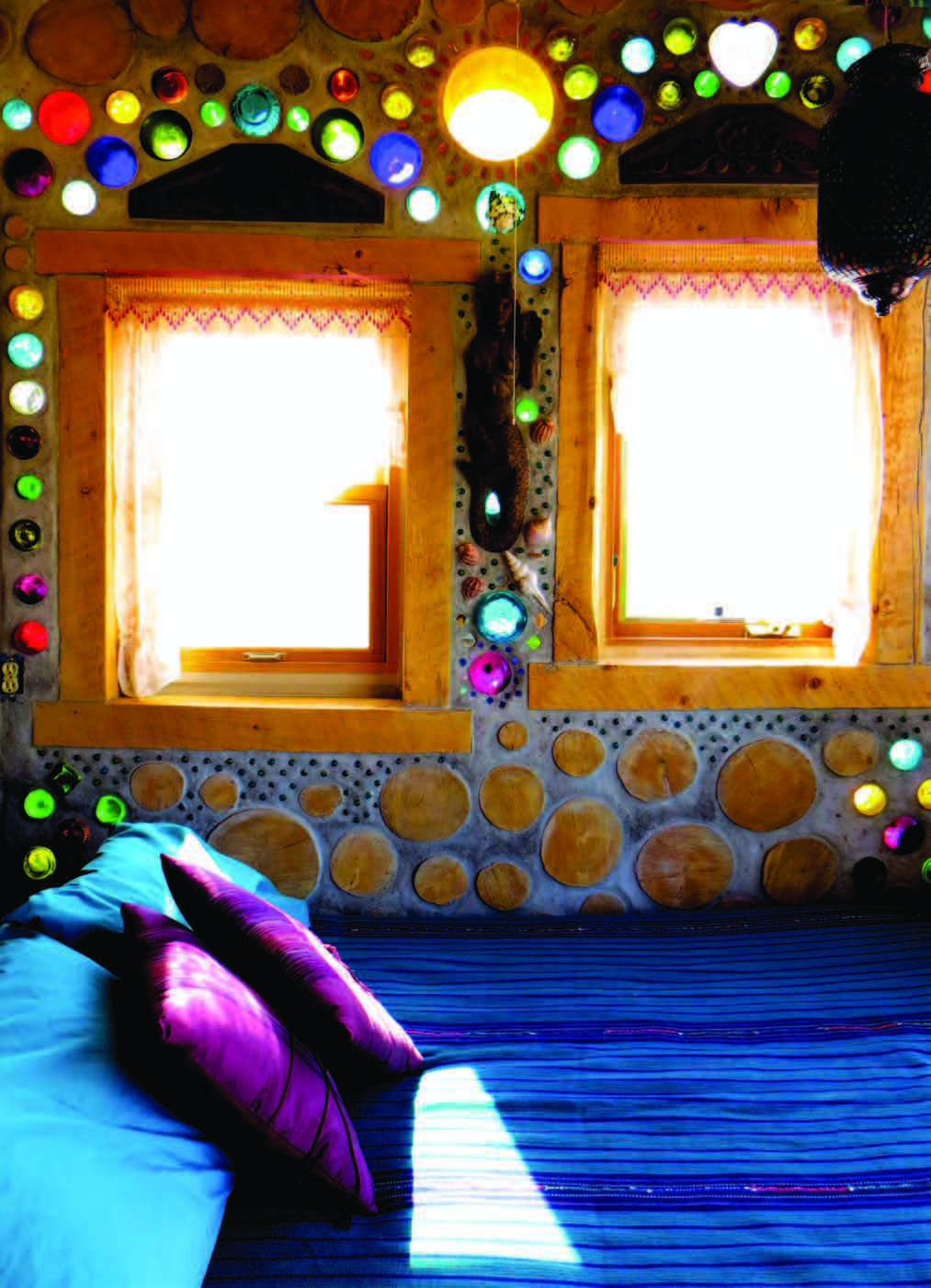
Cordwood and Mermaids in Colorado
KimAnna and Michael Cellura-Shields
KimAnna Cellura-Shields has always loved mermaids. So when she decided to build a cabin using cordwood in Del Norte, Colorado, naturally she created “The Mermaid Cottage.”
“Before I decided to build with cordwood I did a little studying and investigated other forms of alternative building. Although I have a great ap-preciation for other natural styles, from the first time I saw cordwood construc-tion it was love at first sight! Like a siren to a sailor, it called to me. Besides the fact that I have always loved the smell, look, and feel of wood, the bottles in the wall (when the sun shines through) are truly magical! When I was building the Peace of Art Cafe and then the Mer-maid Cottage it was just so darn exciting putting in those bottle walls! Most nights I would work into the wee hours of the morn, then grab a few hours sleep and get up at the crack of dawn just to see the light cascade through those bottles for the first time. I will say that putting a lot of bottles in a wall does take more time, but in my opinion it is so worth it! It feels like you’re living in a beautiful kaleidoscope.
“Another reason I love cordwood? There’s no end to how creative you can get. You’re limited only by lack of imagi-nation. I love mermaids and lots of them … so they became the theme for our cute little cordwood cottage. My favorite wall was also the hardest to do—the all-bottle mermaid shower wall. I combed second-hand stores for fun glass treasures like candy dishes, light globes, and bottles to plant in the walls. I also embedded bro-ken statues, fossils, dead trees, and more into the wall for a funky twist. It’s a great way to recycle, too.
“I totally recommend this style of building to everyone, even if you just use it for one wall of the project. Have fun, the sky’s the limit!” Learn more at Mermaidcottage.org.
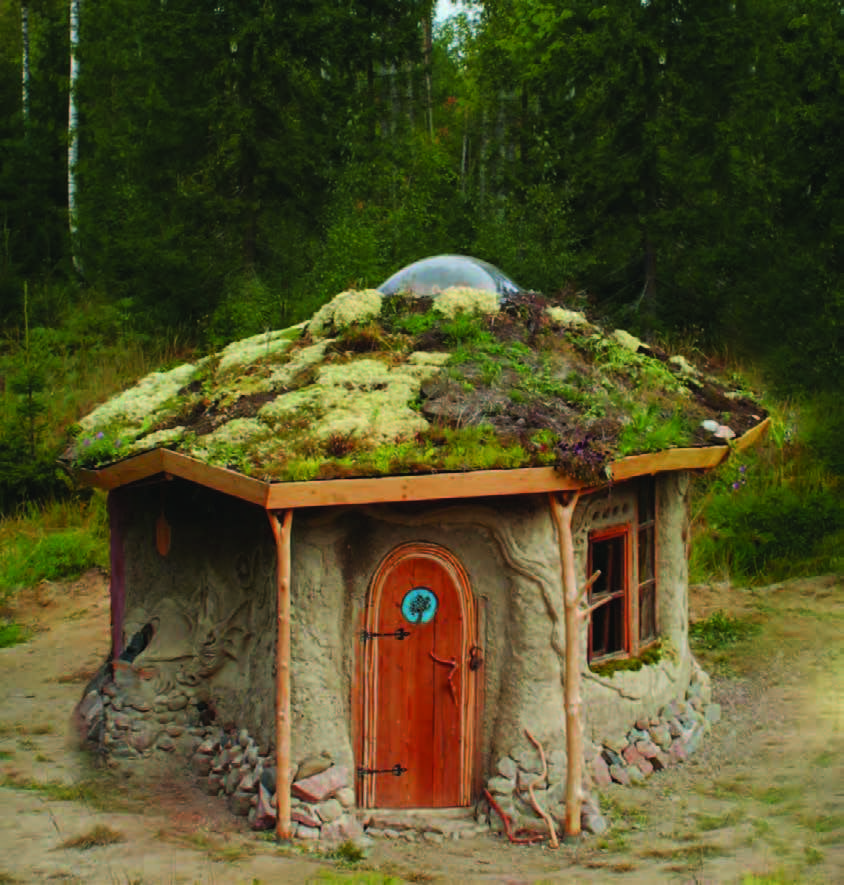
Cordwood in Finland
Heidi Vilkman
In the South of Finland, Heidi Vilkman has built a gorgeous cobwood cottage with her bare hands on the site where she was born. Using materials from the earth, she constructed “Elaman Puu,” or “Tree of Life,” over two summer sojourns.
Heidi built her cottage with a variety of natural building techniques, including a rubble trench foundation, roundwood frame, and an earthbag stem-wall dressed with stone. She also incorporated straw bales and cob and cordwood (cobwood). A living roof tops off her creation. In Heidi’s words:
“I was born pretty much where the cottage stands, and adore the forest, plants, and nature around it. When by pure accident I came across a book on building with cob, I literally fell in love with the concept, the medium, and the stunning photos of natural homes! As an artist, I love working with clay, so the thought of sculpting my own house just seemed too delicious to miss! When I’m inside my cottage, I feel I’m wrapped inside Mother Nature’s womb, which is strong, giving, and nurturing at the same time. My cottage is an homage to the trees and forest where I grew up—and I’ve filled it with my art that tells a story about how nature offers me infinite magic and inspiration.
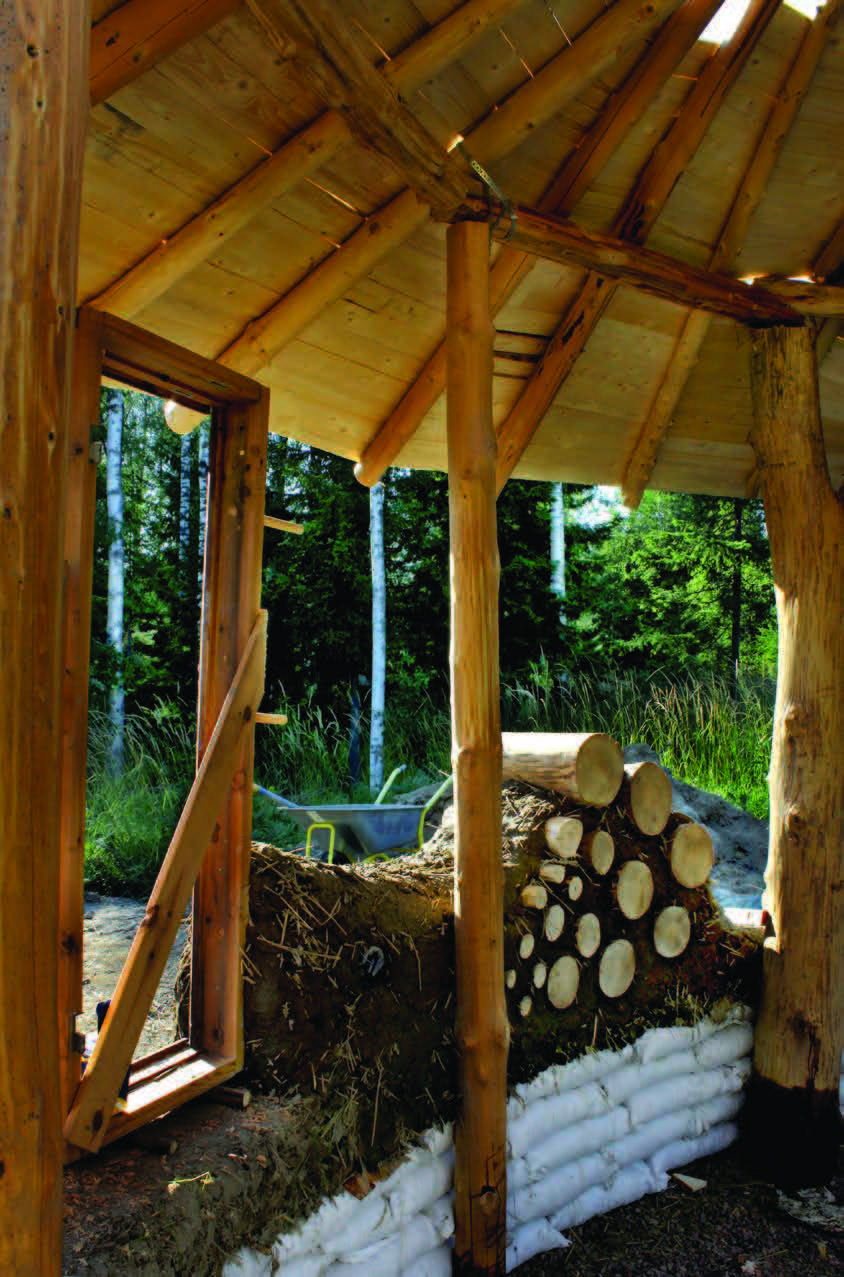
“Nature’s shapes, forms, and textures inspire me—a lot of this inspiration has been used in my cottage. I also believe in magic and fairies (I do, I do, I do), so there are bits of magic to be found in the cottage, and there will be even more when it is finally finished (complete with a ceramic magic mushroom garden). As I’m intending to use the cottage as a seasonal artist studio, the space will be filled with my own wood sculptures, glass hangings, ceramic plaques, and paper cuts. All my work has nature motifs run-ning through it, so the artwork blends seamlessly into these surroundings. Just as when I was planning and building my cottage, my intention is to make my work blend into the forest, to almost become an extension of it. Apart from a bit of plastic, everything in the building is natural and most of the building materials came from within hundred-meter radius from where it stands. All in all, the cottage is my homage to the trees that saw me grow up and Mother Nature that gives us all we need, and more.”
For additional information about Heidi and her other artistic pursuits (jewelry, crafts, cards), visit Heidivilkman.com.
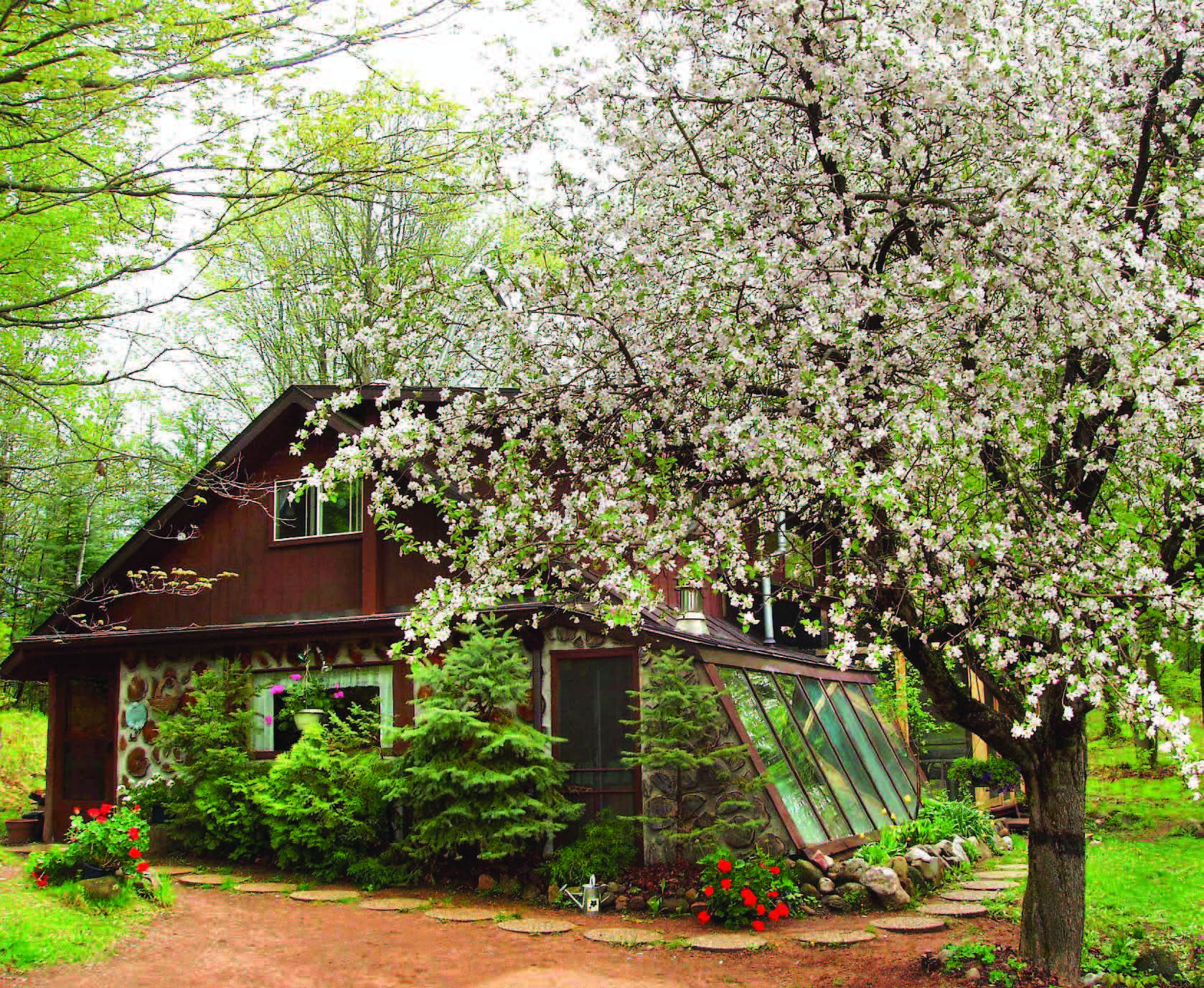
About the Authors
Richard and Becky Flatau Richard and Becky Flatau built their cordwood home in 1979 amidst a glaciated forest in northern Wisconsin. After publishing an article about their building experiences in Mother Earth News, they were deluged with queries and visits. They started hosting work-shops, writing books and magazine articles, and doing interviews on television and radio.
The Flataus relish living in their cedar cordwood home, and have delighted in nature’s beauty and bounty for thirty-five years now. They harvest maple syrup, heirloom apples, wild asparagus, and plums, and the forest surrounding them abounds with wildflowers, stones, ferns, and mosses—where the whisper of wings might be heard.

Flatau’s recently published guidebook, Cordwood Construction Best Practices, is available at their online bookstore at Cordwoodconstruction.org.




























